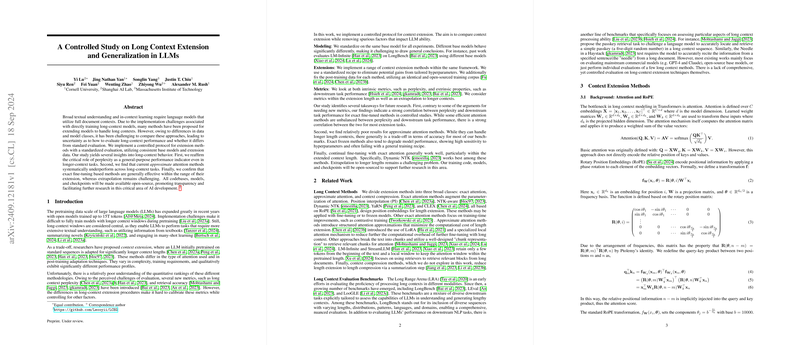A Controlled Study on Long Context Extension and Generalization in LLMs
Recent advancements in LLMs have been underscored by significant enhancements in pretraining data scales, with some models being trained on up to 15 trillion tokens. While expanding context windows during pretraining presents challenges, the ability to handle long contexts remains crucial for tasks requiring extensive textual comprehension such as textbook utilization, novel summarization, and many-shot learning. This paper conducts a controlled paper to compare various methodologies for context extension in LLMs, focusing on performance metrics while mitigating spurious factors.
Methodological Framework
Modeling
The paper standardizes experiments on an identical base model to ensure consistency, specifically using LLaMA2-7B and, in additional experiments, the Phi-2-base checkpoint. This uniformity eliminates biases derived from differences in base models, thereby providing a more accurate comparison of context extension techniques.
Context Extensions
The researchers examine both exact and approximate attention methods for context extension:
- Exact Attention: Methods like Position Interpolation (PI), Neural Tangent Kernel (NTK), Dynamic NTK, YaRN, and CLEX focus on augmenting attention parameterization, typically through variations of Rotary Position Embeddings (RoPE).
- Approximate Attention: Techniques such as LM-Infinite, Self-Extend, LongLoRA, and Landmark Attention aim to reduce computational costs by approximating attention over extended contexts through methods like structured attention and chunk-based retrieval.
Evaluation Metrics
The paper assesses both intrinsic and extrinsic metrics:
- Intrinsic Metrics: Perplexity on datasets like PG19 and Proof-pile, and specialized retrieval tasks like Needle in a Haystack (NIAH) and RULER.
- Extrinsic Metrics: Performance on downstream tasks from the LongBench benchmark and many-shot in-context learning tasks using datasets like TREC News.
Key Findings
Perplexity and Performance Correlation
Contrary to prior studies suggesting a weak correlation, this paper finds a significant correlation between perplexity and downstream task performance for exact attention methods. Approximate attention methods show some deviation but still fit into the observed linear relationship.
Method Effectiveness
- Exact Attention: Continual fine-tuning methods (e.g., Dynamic NTK) consistently outperform both approximate attention and frozen exact attention methods. These methods perform well within extended context lengths and retain accuracy beyond pretraining lengths.
- Approximate Attention: Methods like LM-Infinite and Landmark Attention, while computationally efficient, struggle to maintain accuracy and exhibit poor performance in retrieval tasks when compared to exact attention methods.
Training and Generalization
The paper highlights the sensitivity of certain methods (e.g., LongLoRA) to training recipes and the importance of sufficient training data. Models such as NTK-64K require extensive tokens for training to generalize effectively beyond the pretraining context length.
Implications and Future Directions
This controlled paper underscores the importance of exact attention mechanisms for long-context modeling in LLMs. The strong correlation between perplexity and performance in downstream tasks suggests that refining perplexity as an evaluation metric could provide a clearer picture of a model's capabilities. Additionally, the challenges faced by approximate attention methods imply a need for further research to enhance their efficiency without sacrificing accuracy.
Given the empirical evidence, future developments in AI should focus on optimizing exact attention mechanisms and exploring hybrid approaches that combine the computational efficiency of approximate methods with the accuracy of exact attention. Moreover, extending the context window training length and ensuring sufficient training data are critical for achieving robust generalization in long-context LLMs.
The paper contributes valuable benchmarks and open-sourced resources to support ongoing advancements in context extension methodologies, providing a foundation for future exploration in this critical aspect of AI research.
Conclusion
This paper offers a comprehensive evaluation of long-context extension methods in LLMs, providing clear insights into the trade-offs and performance dynamics of different approaches. By employing a robust and controlled evaluation framework, the research delineates critical factors influencing long-context performance, paving the way for more efficient and accurate LLMs capable of handling extensive textual inputs.
